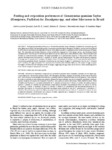Por favor, use este identificador para citar o enlazar este ítem:
http://www.alice.cnptia.embrapa.br/alice/handle/doc/860281Registro completo de metadatos
| Campo DC | Valor | Lengua/Idioma |
|---|---|---|
| dc.contributor.author | QUEIROZ, D. L. de | pt_BR |
| dc.contributor.author | ZANOL, K. M. R. | pt_BR |
| dc.contributor.author | OLIVEIRA, E. B. de | pt_BR |
| dc.contributor.author | ANJOS, N. dos | pt_BR |
| dc.contributor.author | MAJER, J. | pt_BR |
| dc.date.accessioned | 2011-04-10T11:11:11Z | pt_BR |
| dc.date.available | 2011-04-10T11:11:11Z | pt_BR |
| dc.date.created | 2010-08-18 | pt_BR |
| dc.date.issued | 2010 | pt_BR |
| dc.identifier.citation | Revista Brasileira de Entomologia, v. 54, n. 1, p. 149-153, mar. 2010. | pt_BR |
| dc.identifier.uri | http://www.alice.cnptia.embrapa.br/alice/handle/doc/860281 | pt_BR |
| dc.description | Feeding and oviposition preferences of Ctenarytaina spatulata Taylor (Hemiptera, Psyllidae) for Eucalyptus spp. and other Myrtaceae in Brazil. The Australian psyllid, Ctenarytaina spatulata Taylor (Hemiptera, Psyllidae), was first detected in Brazil in 1994, where it was found on drought-affected shoots of Eucalyptus grandis in a plantation located in the northern part of Paraná State. The oviposition and feeding preferences of this psyllid were examined on 19 Eucalyptus species, one Eucalyptus hybrid (Cambiju), three Corymbia species and four native Myrtaceae species (Hexaclames edulis, Marlieria edulis, Plinia trunciflora, and Psydium sp.) under greenhouse conditions. The largest populations of C. spatulata were found on E. robusta and E. pellita, while sizeable infestations were also found on E. urophylla, E. grandis, and the Cambiju hybrid. The plants with the greatest symptoms of damage were E. grandis and E. resinifera. Eucalyptus cinerea, E. benthamii, E. pilularis, and E. dunnii were not infested and E. cloeziana was minimally infested. Among the Corymbia species, the number of eggs of C. spatulata was very low on C. citriodora and C. torelliana. No eggs and nymphs of C. spatulata were found on native Brazilian Myrtaceae. The number of eggs on plants was highly correlated with the subsequent levels of nymphs, suggesting that egg counts can be used as a viable monitoring tool to assist with the integrated management of this pest. | pt_BR |
| dc.language.iso | eng | eng |
| dc.rights | openAccess | eng |
| dc.subject | Praga florestal | pt_BR |
| dc.subject | Psilídeo | pt_BR |
| dc.title | Feeding and oviposition preference of Ctenarytaina spatulata Taylor (Hemiptera, Psyllidae) for Eucalyptus spp. and other Myrtaceae in Brazil. | pt_BR |
| dc.type | Artigo de periódico | pt_BR |
| dc.date.updated | 2017-10-11T11:11:11Z | pt_BR |
| dc.subject.thesagro | Praga Exótica | pt_BR |
| dc.subject.nalthesaurus | Eucalyptus | pt_BR |
| dc.description.notes | Short Communication. | pt_BR |
| riaa.ainfo.id | 860281 | pt_BR |
| riaa.ainfo.lastupdate | 2017-10-11 -03:00:00 | pt_BR |
| dc.contributor.institution | DALVA LUIZ DE QUEIROZ, CNPF; KETI MARIA ROCHA ZANOL, UFPR; EDILSON BATISTA DE OLIVEIRA, CNPF; NORIVALDO DOS ANJOS, UFV; JONATHAN MAJER, CURTIN UNIVERSITY OF TECHNOLOGY. | pt_BR |
| Aparece en las colecciones: | Artigo em periódico indexado (CNPF)  | |
Ficheros en este ítem:
| Fichero | Descripción | Tamaño | Formato | |
|---|---|---|---|---|
| a23v54n1.pdf | 290.44 kB | Adobe PDF |  Visualizar/Abrir |









